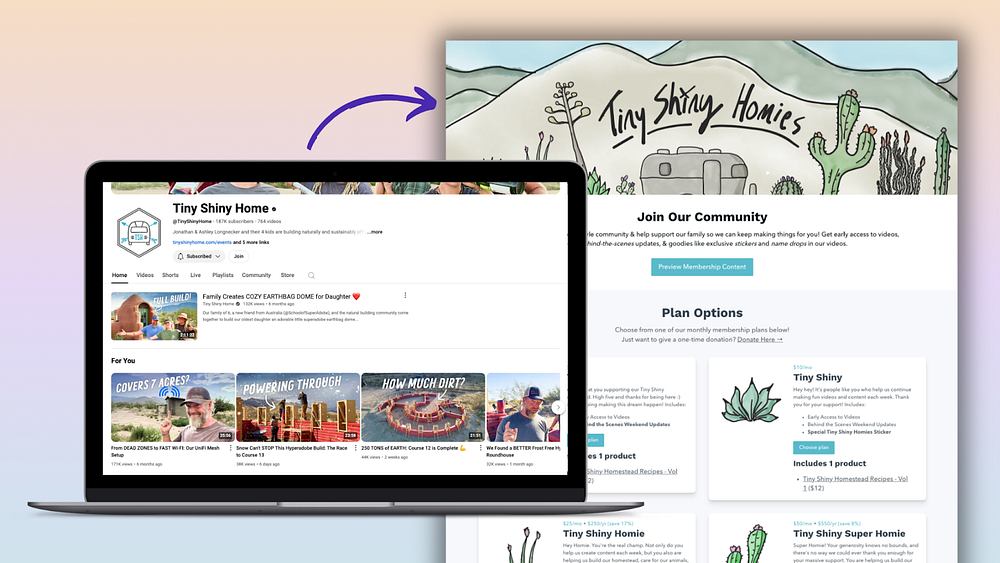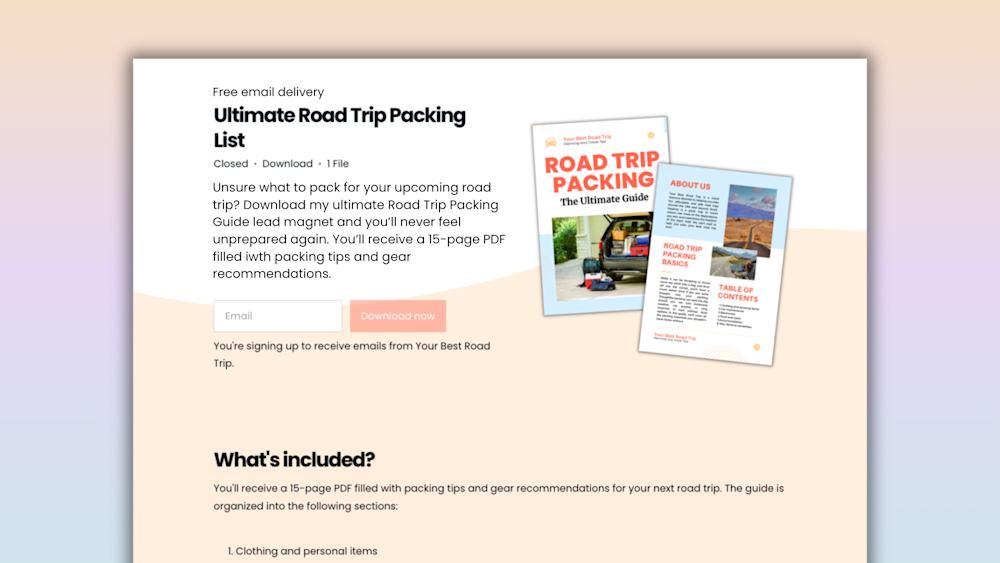You’ve been working on growing your online business and understand the importance of social media.
(You think, anyway.)
But do you really know how to leverage social media?
You ask yourself, “Which strategies work the best?”
Other queries you ponder are, “Where should I spend most of my time? And what are the most essential social media tactics to use?”
After all, you’re a solopreneur business owner with limited time and budget.
You simply don’t have the luxury of trying to figure it all out on your own.
While there are so many social media “experts” out there, it’s time-intensive to dig through each of their strategies to uncover what should be your biggest priorities.
To cut through the noise, we sat down with the founder of MeetEdgar, Laura Roeder, in an exclusive webinar where she revealed her tried-and-true tips on how to use social media platforms to sell your digital products and grow your online business.
Let’s dig into what she revealed.
The 3 most important things you need to know about social media marketing in 2019
#1. Don’t be attached to one platform
Because social media platforms are always changing, Laura cautions working solopreneurs and entrepreneurs not to become attached to any one channel. Instead, she advises you to be “pretty agnostic . . . and really keep your eyes open on where your audience is.”
Finding the best social media platform for your business isn't a one-and-done thing. The social media environment is ever-changing.
“One thing that is always changing about social media is the platforms and how the platforms decide what's shown,” she reveals.
“I'm a believer in not being too attached to any platform because they do change all the time, which we've seen even since Edgar launched in 2014,” Laura continues. “Instagram has become much bigger for marketers.”
Instagram is bigger for everyone in general. By their own estimates, Instagram has over 1 billion users monthly, and over half-a-million users active daily.
If you weren’t anticipating such growth back in 2013, you’re not alone. It’s difficult to predict where social media crowds will congregate, which is Laura’s point -- what’s popular today may be as dead as MySpace by tomorrow.
So don’t get too attached to platforms and be ready to move when your audience does. And, for that matter, be receptive when your audience’s needs and preferences on individual platforms change, too.
#2. Use live video
The second most important thing to know about the latest in social media is the impact of live video.
Live video “is huge right now,” and it’s also what “the platforms favor,” Laura pronounces. “The networks love live video, Facebook loves live video, and, of course, Instagram really loves ‘stories’ and Instagram Live.”
So if you haven’t used live video yet, you definitely need to start ASAP. Fortunately, doing so isn’t difficult or expensive.
To start with live video, you don’t need professional equipment, such as a pro camera or a mic with more attachments than a keychain. The iPhone can record and stream stunning videos, as can any mid-tier or higher smartphone.
It’s less about the window dressing with live content and more about the quality. “Your content is so much more important than how it looks,” Laura reassures.
So you can focus more on producing valuable content for your audience than looking sharp and camera-ready with a perfect movie set background. For live video, it’s OK to let go of your perfectionism.
It’s worthwhile, too, since live video is the format 82% of people prefer to consume from a brand.
Plus, even if only a few people show up to your live video session, platforms like Facebook will reward you and boost your visibility overall because you’re doing what it likes. Laura explains:
“Here’s the thing -- if you're doing the stuff they want you to do, like a live video once a week, Facebook and the other platforms often boost everything else and give you more visibility across the board.”
People can watch your live video later, too, and you can advertise the recordings to gain more exposure. So all is not lost if you have a less-than-desirable number of shows during your live video.
Laura’s final piece of advice when it comes to live video is to “make sure you have some content planned and ask some questions.” That way, you’re not relying on your audience to ask you questions.
Does planning your content ahead of time sound daunting or time-consuming? It doesn’t have to be. At least, not if you’re following Laura’s third golden rule.
#3. Repurpose your content
Creating content is resource-intensive: it takes time, focus, and if not money, lost sleep. Fortunately, you don’t need to commit to a life of toiling away at content -- repurposing your content can be just as, if not more, effective.
Marketers know this more than most people. 29% of leading marketers systematically reuse and repurpose their content.
“I'm huge on repurposing content,” Laura divulges. “Write or create one really great anchor piece of content and then put it all over the internet. Whether it's a video or something written, this is still really important in 2019.”
So if you’re stressing about how to keep up with the creative load of publishing a new story regularly -- even daily -- don’t be.
At its best, it’s unnecessary, and at its worst, it takes attention away from other aspects of your business.
“If you've written something or created something on one platform, there's a smart way to distribute it to [other formats] the social networks are really favoring, like videos or live videos,” Laura declares.
Did one piece of content resonate with your audience really well? Then try changing its format for distributing it on your social channels.
The key here is that you don’t treat it as a copy-and-paste operation -- you still need to give it a new light to keep your loyal followers engaged.
As a particularly meta example, you could take a webinar that went over well and turn it into a blog post -- that’s what you’re reading now -- or use a popular live video recording to create a checklist.
If you prefer a visual model to follow, this illustration from Jeff Bullas shows the different evolutions that an ebook can take and the best channels for distributing the repurposed content.
OK, now that you have the top three important social trends for this year, let’s zoom out and look at Laura’s tips for social media novices.
What to focus on if you’re new to social media
For creators who are just starting out, Laura advises building your social media presence and then your email audience, starting with your current follower list.
From there, you can collect emails and expand your social presence further by branching off to accounts similar to those of your followers.
Her second biggest piece of advice for newbies is to send people off-site from your social channels where they can either make a purchase, opt-in to join your email list, or both.
“Think about it as the home base that you're pointing people to,” Laura recommends, “Make sure you have that foundation built so when you're building your audience, you're sending people somewhere where they either purchase from you or get on your email list.”
It’s vital to capture emails so they can stay in touch with you and make a purchase with you later on.
Another tip for those of you just starting out is to collaborate with others and post other people’s content, which Laura refers to as “OPC”.
The benefit is mutual. Both of you get the opportunity to build your audiences when you promote OPC.
If you’re thinking larger organizations won’t want to collaborate with you because of your scale (or rather, lack thereof), think again. What matters is not the size of your audience, but rather, the quality of what you have to share.
“If you have something valuable for their audiences, they’re happy to have you share that value with their audience in one form or another,” Laura encourages.
So, get out there and share OPC, and while you’re at it, ask them to collaborate with you.
Beyond that, Laura suggests you should focus on showing up as a newcomer on the scene.
Beginners, she explains, “Need to have a constant presence to increase your chances of getting your content shared.” It’s the only way you’re going to encounter opportunities for growth.
“Sometimes someone retweets you on Twitter, and you get in front of 100,000 people,” she explains. “But that's not going to happen if you're not putting out a lot of stuff that can be retweeted.”
Thanks to Laura’s tool, MeetEdgar, making those opportunities happen doesn’t have to take years off your life.
Loading your content and publishing is straightforward, but most importantly, MeetEdgar solves the biggest hurdles behind repurposing content -- organizing and distributing it.
You can easily sort your content into a library and ensure your social accounts are “filled up day in and day out”. Plus, it also makes it a cinch to share OPC.
Of course, collaborating with other people doesn’t have to stop at just sharing each other’s content. When you’re ready to expand your network more, you’re ready for Laura’s next recommendation -- working with an influencer.
How to reach out to social media influencers
If you want to expand your audience reach by partnering with social media influencers, Laura’s advice is not to offer a free online course or digital product.
Instead, pay social influencers directly or offer an affiliate agreement.
The reason is it’s time-intensive and too big of an ask for influencers to consume your digital products. “Usually, people are not going to be so keen to promote your business in exchange for free product, especially with a course, because it is more time-intensive,” Laura warns.
So the better solution is to pay influencers directly. Influencer outreach is contingent on the influencer's schedule as much as your own.
“And that can be a really small fee, especially if they have a smaller audience,” she explains. “Maybe $50 would be an appropriate amount. You can also do an affiliate agreement where they promote you via an affiliate link.”
In which case, when the social influencer makes a sale on your behalf, they get paid an affiliate commission.
To create an impactful affiliate program, Laura suggests creating various assets, using different image sizes for different social networks, and highlighting different features about what’s being sold.
Following this formula will put you miles ahead of typical affiliate programs. “Almost no one does that. So if you do that for your affiliates, they will use those images,” Laura claims.
She’s right, too. Sadly, fewer than 25% of merchants provide custom assets to help their affiliates promote their offers.
(Don’t have an affiliate program yet? You can launch and manage your own with just a few clicks of a button with Podia. Try it today with a free 30-day trial.)
As far as telling people when to promote your products, instead of asking them to interrupt their planned calendar, simply “tell people when you need them to help you promote it and then they'll do it.”
Doesn’t get much simpler than that, right?
Fortunately, our next topic -- competing in a crowded market -- is also simple to solve, though it takes a little more elbow grease.
How to compete in a crowded market
To overcome a crowded marketplace, Laura advises you to “bring your own personal brand to the table.”
This means, rather than trying to create a brand that perfectly mirrors the industry, add your own unique element and personality to it. Your business and brand should be one-in-the-same with your (public) personality.
“Something really cool about the online course business is your business is you,” Laura affirms.
“Your business is your personality and your brand.”
Another piece of advice is to not rely on your niche or minor technicalities to stand out from your competition. Instead, focus on engaging with your niche.
“Don't try to stand out because you have one more video or one less video. And don’t just rely on your niche,” Laura asserts. “Niche is part of it, but you really need to connect with that niche.”
If you’re still intimidated by your crowded target market, a perspective shift may help. Crowded markets can be a good thing -- after all, a busy marketplace means it’s full of customers who have problems to solve.
“Just because it exists already is not a good reason for you not to do it,” she coaches. “And it's not a good reason for you not to market it.”
Finally, when it comes to pricing, ignore what other people are doing. Even if your competitors are offering longer courses for less money, don’t let that dictate your business decisions.
People like to purchase from several places and consume lots of content.
“I've never heard of anyone who purchased just one cookbook. It's just not a thing,” Laura explains. “In fact, if you can deliver the same information in a shorter amount of time, that's often a huge value-add for your audience.”
Bottom line:
Focus on offering an online course or digital product that delivers a valuable outcome unique to you and your personal brand. Ignore what your competition is doing when it comes to their pricing.
“I would really advise in this market not looking at your competition,” Laura suggests. “If you're creating courses, I wouldn’t worry about what they're doing, and I wouldn’t worry about how they're pricing.”
Instead, focus on building your brand and branching out with new products on social media. What you’re doing as a creator matters far more to your audience, present and future, than what your competition has afoot.
How to diversify your business on social media
To diversify your business with new products in different categories across multiple audiences, Laura’s advice is to stick to one set of social media accounts.
“Do not create multiple social media accounts,” she warns, “people don't know which account to follow. It makes it really hard to follow you because you have so much going on.”
Another reason you shouldn’t go overboard with social accounts is it’ll create confusion for you. “What you'll find is you'll create new content, and you won't know which account to send it to, or you'll end up sending it to all accounts,” she explains.
And the confusion you feel will only be amplified for your audience.
What to do instead?
Ensure your social accounts and your offers are all about you and your personal brand. Focus on offering your unique educational value.
“This is why it works out way more often than people would guess when going into different markets and different categories,” Laura boasts. “People are often there because they resonate with you, and they love your wisdom.”
Two examples of entrepreneurs who do this well are Tim Ferriss and Pat Flynn. They have very diverse businesses, yet they make all their business ventures about their personal brand.
Summing it up nicely, Laura advises:
“Don't be afraid to create multiple businesses if that's what you're passionate about,” Laura encourages. “Just make your social accounts about you.”
And if that still isn’t pulling in the kind of sales you want to see, follow Laura’s next piece of advice.
What to do if no one is purchasing your paid offer
For those of you who are struggling with sales (and only having success with people opting in for your free offers), Laura first recommends offering discounts and using deadlines.
These two tactics alone will help inspire your audience members to take action.
Why?
Deadlines and discounts create a sense of scarcity and urgency.
And, to put it plainly, they work. 90% of consumers use coupons in some way, and by 2022, $91 billion in digital coupons is anticipated to be redeemed.
Another tactic Laura recommends is to try finding your target audience in other complementary online groups and places of interest, such as Facebook groups. Your current social group may not be the right audience for the content and offers you’re releasing.
The solve is to ask your current group questions about where they hang out, what other Facebook groups they’re in, what blogs they read, what podcasts they listen to, and et cetera.
That way, you’ll be able to tap into complementary groups with people who might benefit from your offer rather than “swimming in your own little pond with other entrepreneurs” who don’t necessarily want your paid offer.
The more you branch out with your social following, the better for your paid offers -- though, as with anything, social media growth will add a new layer of complexity. To keep things orderly, Laura has a (very lenient) formula for you to follow with your posting schedule.
The best formula for your social posting schedule
As far as posting frequency goes, Laura’s words of wisdom have only one theme: “It's rare that you can post too much.”
Sure, the optimal frequency of your posts depends on several factors -- like the algorithm, social network, and your visibility -- but overall, Laura claims, “It’s very rare that I see a business posting too much because every post is a new opportunity to reach someone new.”
After all, social media is a numbers game. Not everyone will see everything you post, which means it’s worth experimenting with a heavier posting schedule.
“Because people pop in and out of social media, post 20 times a day as long as it's something relevant to your audience,” she urges. “They don't see 20 posts, right? If you post 20 times a day, they might see one. If you post three, they might see none.”
Laura goes on --
“You’d be shocked by how often you can post.”
If you’re looking for a recommended balance between content types, Laura says to shoot for a posting ratio of 30% promotion and 70% content.
Her other piece of advice related to your social posting schedule is to “mix things up” and share various images, videos, and content sources throughout the day. This will help you catch followers in different time zones, too.
“You absolutely want a mix of promoting your own content, promoting other people's content, and putting in direct offers,” she coaches.
So don’t feel pushy, guilty, or like you’re going to lose followers by posting often. Using social media for small business is a numbers game, plain and simple.
“If people are following you online . . . they’re clearly interested in your business in some way, shape, or form,” Laura assures. “I think we often forget, social media is all opt-in . . . That's what's so cool about it . . . they chose to click that follow button.”
Upgrade your social media plan with a few simple tweaks
You don’t have to try everything under the sun, nor do you have to swim through mounds of supposed “expert advice” to find the most impactful way to kick off your social media campaigns.
To summarize:
-
The three most important things you need to know about social media marketing this year are to remain unbiased across platforms, tap into live video, and repurpose content.
-
If you’re just starting out, focus on building your social presence and email list, direct your audience to an opt-in page, collaborate with others, and share other people’s content.
-
When reaching out to influencers, pay them either directly or through an affiliate program, and support them with promotional assets.
-
Competing in a crowded market is a good thing, so long as you focus on your personal brand instead of what your competition is up to. This should also be the same focal point for diversifying your business.
-
If people aren’t opting in for your paid offers, use deadlines and discounts, and be sure to target the right audience.
-
Your posting schedule should include very frequent posts and consist of 30% promotion and 70% content.
Not too overwhelming, right?
It’s time to leverage Laura’s words of wisdom and see for yourself how powerfully social media can serve your business. Happy posting.



